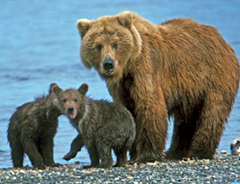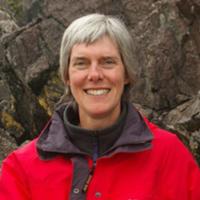
Bruce McLellan has caught more than 150 grizzlies in the Flathead Valley in the past 29 years, some more than once, but he still vividly remembers his first capture.
"We got really excited when we drove in and could see this big bear... bouncing around," McLellan recalls. Then alarm set in -- the tree that had anchored the snare was gone. "He'd gnawed it down!"
Luckily, the cable remained attached to the stump and the young biologist soon had the 290-kilogram bear tranquillized and radio-collared. It was the start of what's become one of the world's longest-running, most in-depth studies of this species.
Since 1978, McLellan -- now a provincial Ministry of Forests senior wildlife habitat ecologist and University of British Columbia adjunct professor -- hasn't missed a year in the Flathead. His research shows that this 1,575-square-kilometre watershed in British Columbia's southeast corner has the highest documented density of grizzlies in inland North America: 65 to 80 for every 1,000 square kilometres. Only salmon-fed coastal grizzlies occur at higher densities.
"What's special about the Flathead," McLellan says, "is that it's a big, wide valley with no people living in it, so the bears can use the whole valley bottom and do what bears do when there's no people around. That's what makes it unique, more than the density.
"And it's not just bears," he adds. Other predators and their prey thrive in the Flathead simply "because no people live there." Unlike every other major valley in southern B.C., this one has no ranches, farms, towns or resorts. Instead, and not coincidentally, it is home to numerous top-of-the-food-chain predators, including grizzlies, black bears, wolves, wolverines, cougars, lynx, martens and fishers.
A 2001 Wildlife Conservation Society report on the Flathead Valley, which stretches across the Canada-U.S. border, states that it "may be the single most important basin for carnivores in the Rocky Mountains," because of its unmatched carnivore species diversity and its "strategic position as a linkage between national parks in both countries" -- Waterton Lakes and Glacier to the south, Banff, Yoho and Kootenay to the north.
History of resource extraction
The Flathead River flows just 50 kilometres within B.C., from its origin about 20 kilometres southeast of Fernie, to the international border. In Montana, where it is called the North Fork of the Flathead, it continues 75 kilometres south, then empties into Flathead Lake. Marking the western boundary of Glacier National Park, the North Fork is federally designated as a Wild and Scenic River.
The entire Flathead Valley is broad and open, rising gently in a series of flat benches and rolling hills. To the east, it is bounded by the dramatic Clark and Livingstone ranges. To the west are the more subdued Macdonald and Whitefish ranges.
One July afternoon two years ago, I paddled the lower Flathead starting about 15 kilometres north of the border. Although there was no sign of any grizzlies, the muddy banks were laced with tracks: sharp hoof-marks of moose, deer and elk -- main prey of the valley's large carnivores -- and wolf prints, some as wide as my hand.
Enveloped by lush riverside greenery, the Flathead felt wild and far removed from civilization. Back on the road, however, there was no denying the human presence.
The Flathead has a century-long history of exploration for oil, gas, coal, and coal-bed methane reserves, with promising discoveries, though no commercial production. Industrial-scale logging started later, in the 1950s, but has been more intensive. In 1980, at the height of a decade-long mountain pine beetle outbreak, more than 200,000 cubic metres of wood rolled out of the valley. The legacy of these activities is an extensive network of gravel roads that criss-cross the watershed.
New roads continue to be built, most recently across a forested ridge above Foisey Creek, a headwater tributary of the Flathead. This is where Sudbury-based Cline Mining Corporation intends to develop an open-pit coal mine, hoping to extract two million tonnes of coal annually for 20 years. The proposal is currently being evaluated by B.C.'s environmental assessment office -- and fought by environmentalists.
'Staggeringly high' selenium levels
"Right now, the most immediate threat to the Flathead is coal development," says John Bergenske, executive director of Wildsight, an East Kootenays-based conservation organization. "We don't want to see any coal mining in the Flathead, full stop."
Of particular concern are potential impacts on the watershed's 300 or more species of aquatic invertebrates and 10 fish species, including bull trout and westslope cutthroat trout.
For Cline Mining CEO Ken Bates, the nearby Elk River, with its long coal-mining history, is proof that the Foisey Creek project poses no threat. "On the Elk River, there are mines that produce 26 million tonnes of coal a year without any problem," Bates says. "The Elk is a pristine river. The fishing's great."
Richard Hauer sees it differently. "I personally would never eat a fish out the Elk River," declares the University of Montana professor of limnology, who has been studying freshwater ecosystems in the Flathead Valley since 1976.
Among the findings from Hauer's research on Michel Creek, an Elk River tributary associated with the active Coal Mountain mine, are concentrations of selenium that are "staggeringly, stunningly higher" than those in Foisey Creek or the Flathead River, as well as significantly reduced invertebrate diversity. "The sensitive species all get knocked out," says Hauer, "and only the tolerant species are left."
Industry eyes the valley
Like many Montanans, Rich Moy shares Hauer's passion for protecting the Flathead. "It's probably one of the most undisturbed ecosystems left in the lower 48 states," says Moy, chairman of Montana's Flathead Basin Commission. "And we're downstream. We have nothing to gain and everything to lose."
In the late 1970s, Montanans steadfastly opposed an open-pit coal mine proposed for a B.C. site just west of the river and 10 kilometres north of the border. The scheme was finally shelved after being rejected by the International Joint Commission.
Now industry is eyeing the valley again. In addition to Cline Mining's proposal, Western Canadian Coal Corp. is promoting an open-pit mine on the Flathead floodplain, just downstream from Foisey Creek, and BP Canada Energy Co. plans to spend three to five years and $100 million investigating coal-bed methane production in an area that includes the upper Flathead Valley.
In 2003, renewed interest in the Flathead's resources prompted B.C. and Montana to sign an environmental co-operation pact. Four years later, the two governments are still arguing over the action plan.
Frustrated by the lack of progress, Montana governor Brian Schweitzer recently joined the U.S. Environmental Protection Agency and American Secretary of State Condoleezza Rice in calling for a cumulative-effects assessment of all anticipated developments in the valley, under Canada's Environmental Assessment Act. Fisheries and Oceans Canada has acknowledged the act's applicability to the Cline Mining proposal, but an assessment won't be undertaken until federal and provincial officials agree on the process.
Deal with logging firm
Discussions about forestry activities in the valley have progressed somewhat more smoothly. In May 2005, three conservation groups -- Wildsight, ForestEthics and the World Wildlife Fund -- signed an agreement with Tembec Inc. as part of the company's successful bid for Forest Stewardship Council certification in B.C.
"The essence of the agreement is that we will manage identified HCVFs [High Conservation Value Forests] and maintain their attributes," explains Troy Hromadnik, Tembec's vice president for western Canada. "It's the rules of engagement for how we will do this."
Under the agreement, Tembec, the main forestry company operating in the Flathead, has suspended logging and road building in almost half of the valley, to give conservation organizations time to pursue long-term protection strategies. The deferral won't last forever, though; according to Tembec, the company "will very likely require operational access to this area within the next four years."
"It's not that we don't want to see any logging in the Flathead," Bergenske says. "What we're looking for is to make sure it's managed appropriately and that there are [unlogged] reserves in key parts of the watershed."
National park envisioned
Despite the regenerating clearcuts and remnants of old petroleum exploration camps, despite the crates of mining test cores stacked beside a raw new road, the Flathead still feels unspoiled. But a piecemeal approach to keeping it wild may not work for much longer. That's why Wildsight, the Canadian Parks and Wilderness Society, and the Yellowstone to Yukon (Y2Y) Conservation Initiative are jointly pushing for more permanent protection.
The groups are seeking national park status for the corner of the valley that lies adjacent to Alberta's Waterton Lakes National Park and Montana's Glacier National Park. They also want the B.C. government to establish a Wildlife Management Area that would encompass the Flathead and parts of the neighbouring Wigwam, Elk and Bull watersheds. This proposed corridor would allow wide-ranging mammals, such as grizzlies and wolves, safe passage between the Flathead-Waterton-Glacier core wildlife reserve and the more northerly haven formed by Banff, Kootenay and Yoho national parks.
It's an ambitious proposition, but according to Bergenske, no less than the Flathead deserves. "The diversity of plant and animal life in this valley is unparalleled in North America," he says. "We need a plan that protects this magnificent place."
Tomorrow, part 2: the push to make the Flathead Valley a national park.
Related Tyee stories:
- Who Are Great Canadians?
Five people who prove our nation's potential, including a Flathead Valley activist. - Clash over Coalbed Methane
Northern towns rebuff push by government. Special report. - 'War Brewing' over Mining Rights in Rural BC
Infuriated landowners rally to regain control of their property. A special report.
Read more: Labour + Industry, Environment














